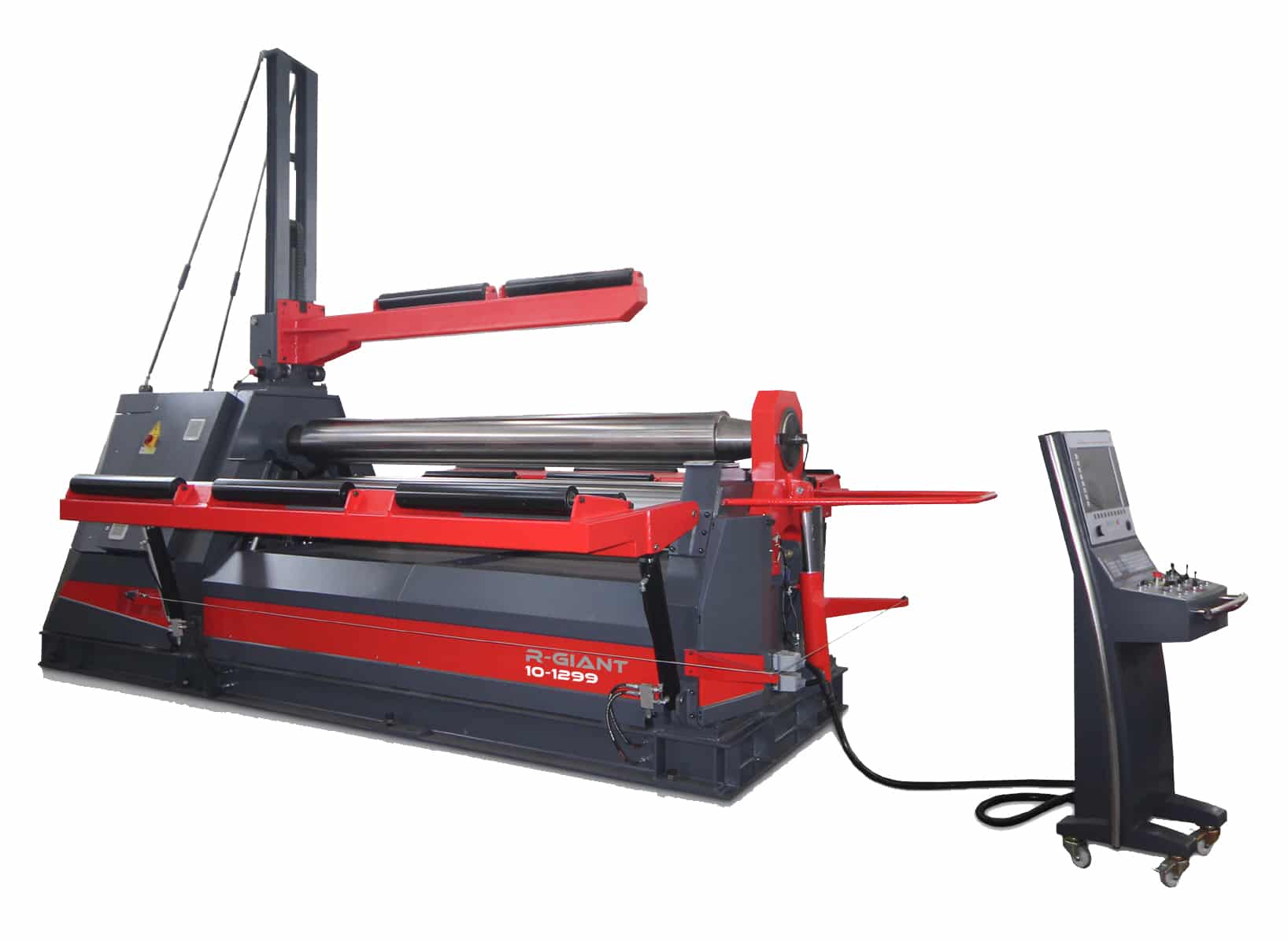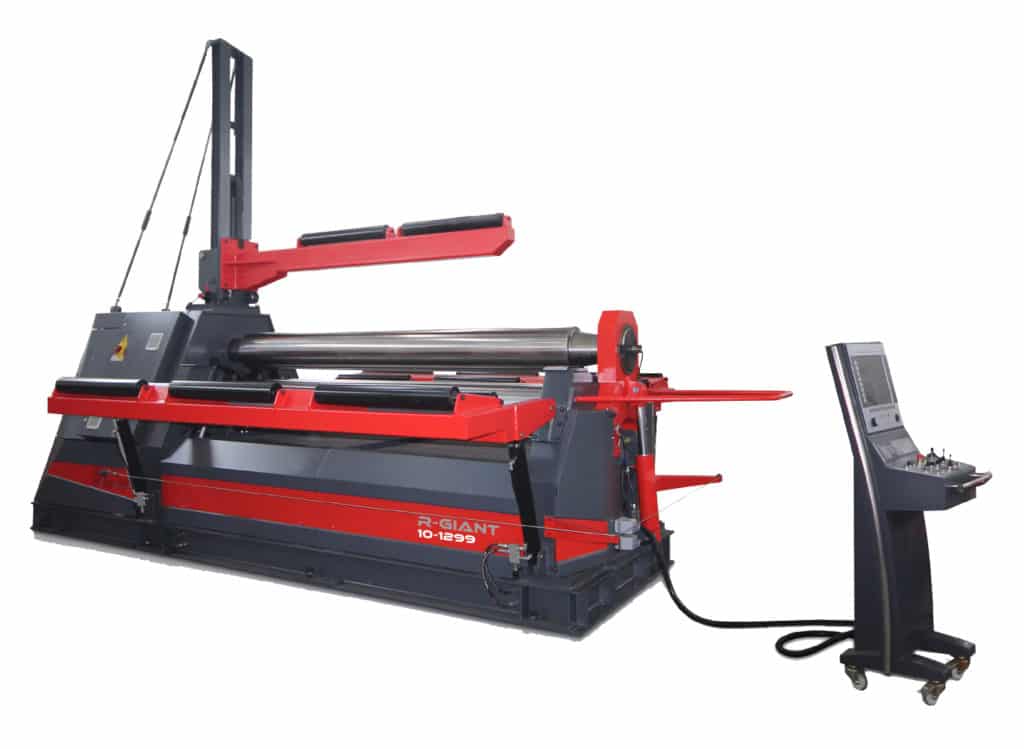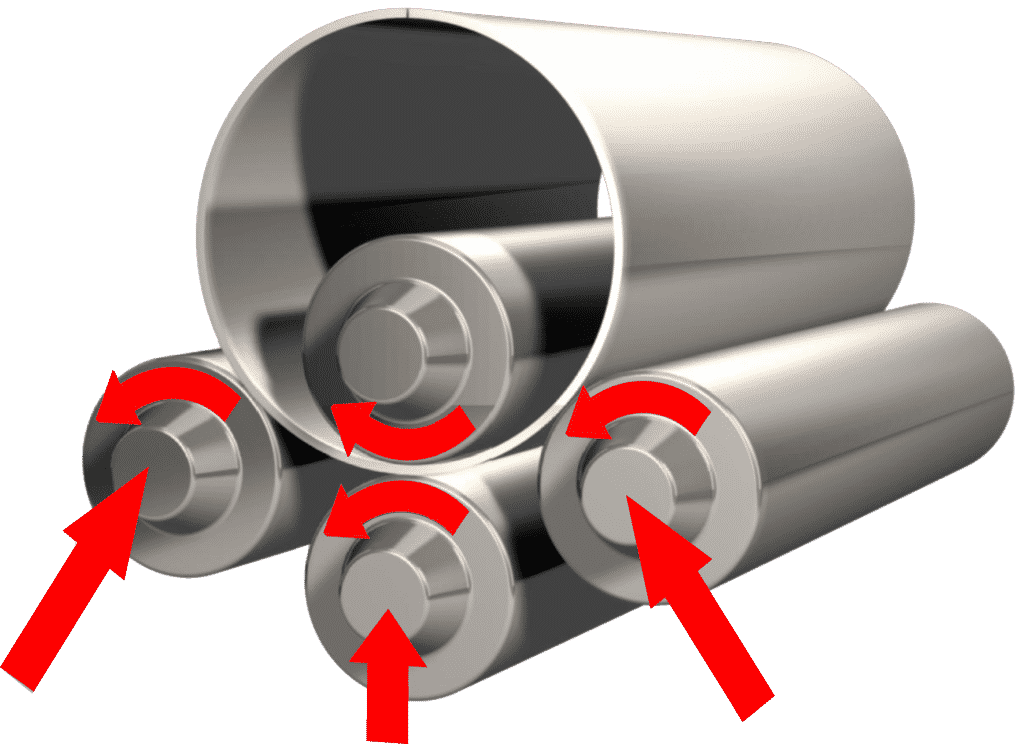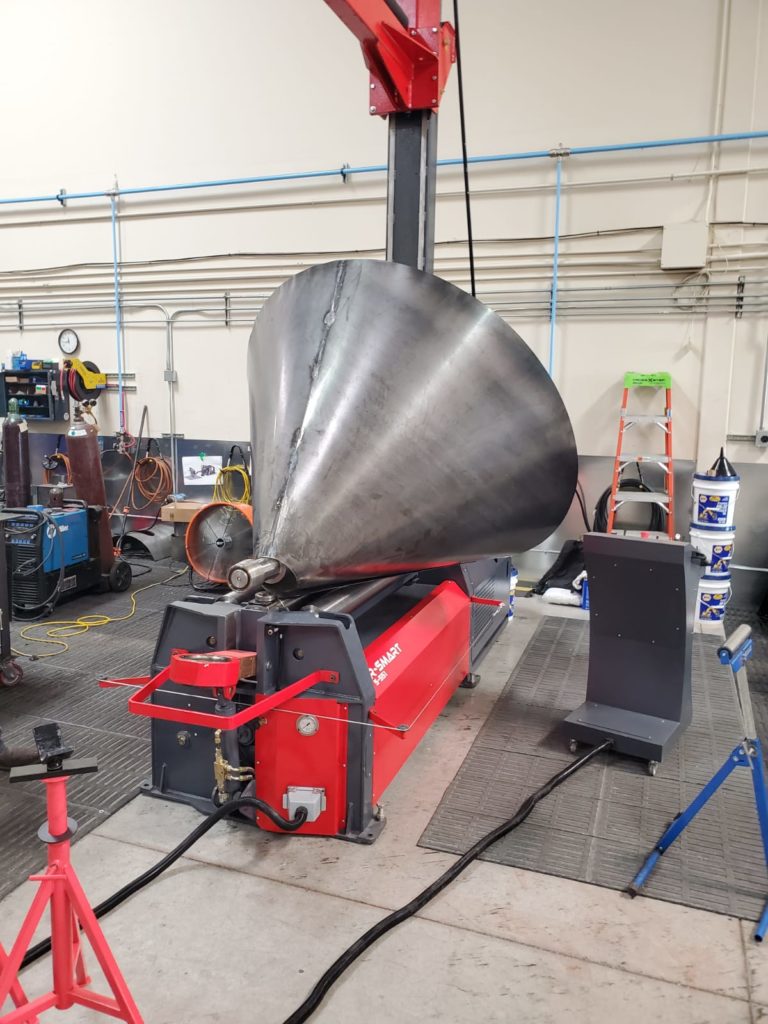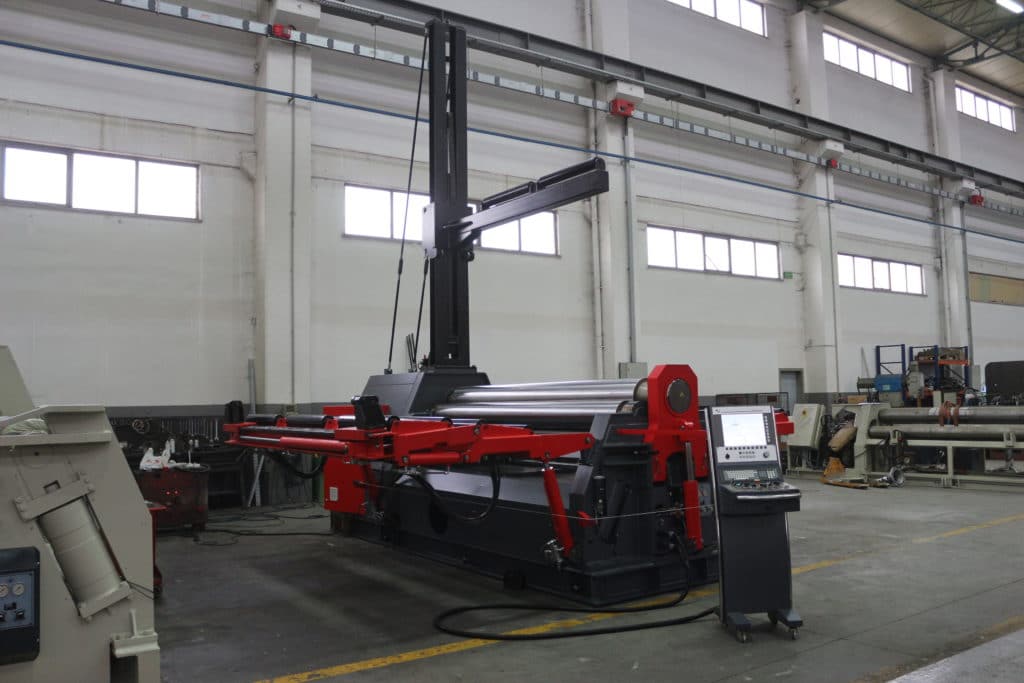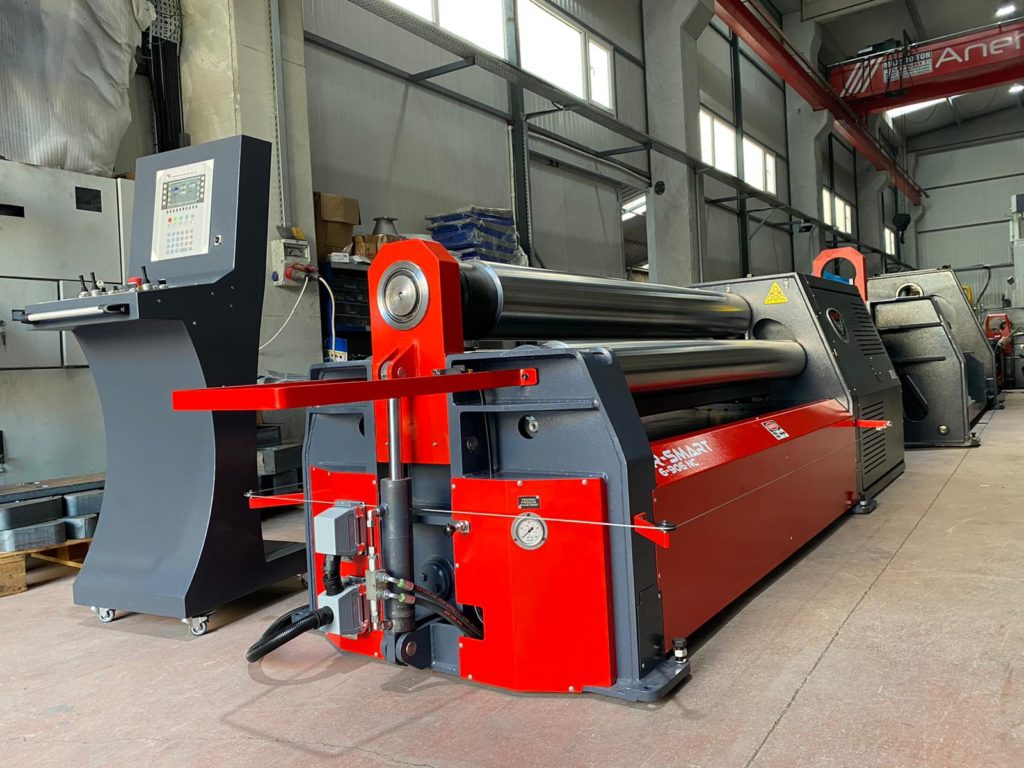In spite of the continued proliferation of three-roll bending machines in the market today, four-roll plate rolls are steadily becoming more dominant in the plate and sheet metal fabrication industry because of their general superiority.
While three-roll asymmetrical initial pinch machines are still the go-to for rolling light gauge sheet metal, four-roll benders are the better choice for rolling everything from 10-gauge steel up to plate a few inches thick.
Here’s a brief A-to-Z guide to some of the major benefits of purchasing a 4-roll plate roll:
- Accessories | Because of the advanced mechanisms and larger capacities available in 4-roll machines, most manufacturers have a wide range of options and accessories that can be added to give these machines even greater efficiency. Higher quality components, like hardened and ground rolls, are usually available, if not included as standard features. Automated infeed tables can keep the rolls turning by having the next plate preloaded while the current plate is being rolled. Hydraulic side supports and overhead supports help plate rolls accommodate larger diameter finished parts. The design of a 4-roll plate roll keeps a workpiece very secure, allowing NC and CNC units to be added. With an additional 30% investment over the cost of the machine, fabricators can own a plate roll that can give them up to 70% more productivity.
- Accuracy | The greater precision that 4-rolls offer is due largely to their unique material clamping ability, something not found in their 3-roll cousins. This constant pinching and driving of the workpiece from the initial loading of the metal to the removal of the finished part means that accurate tracking is available throughout the bending cycle. Using rotary encoders to track the exact position of the plate allows an optional CNC unit to be added to give very precise control of each stage of the rolling process. The side rolls are on their own independent axes, allowing for even greater accuracy.
- Cone Rolling | The extra roll on a 4-roll makes cone rolling much easier. Manufacturers will often make use of angular contact bearings that shift in the bearing housings to allow the bottom and side rolls to be tilted to establish a tight cone. Four-roll machines will usually feature a cone shoe (snubber) that can rotate into position at the end of the top roll and keeps the part in position while rolling cones.
- Construction | Because they are used for more demanding jobs, good 4-roll machines are built with heavier, reinforced steel frames and equipped with top-of-the-line components. The best manufacturers will use industry-recognized parts that can be easily replaced off-the-shelf from local suppliers worldwide, rather than holding their customers hostage waiting for factory-specific replacement parts to be shipped.
- Ease of Operation | Most operators consider 4-rolls to be the easiest rolls to learn as well as the easiest to use. Because the plate is clamped securely during the squaring process and held throughout the operation, newer fabricators can perform various functions such as prebending and cone rolling with the precision of seasoned plate roll operators.
- Guide Options | Most modern, pyramid-style plate rolls have side rolls that move up and in towards a stationary top roll. They are driven either by “planetary” or “rectilinear” guides, so named by how the rolls move. Planetary guides move in arcs toward the top roll (much like the curving orbits of planets), while rectilinear guides move in a straight diagonal line towards the top roll. Some manufacturers will opt for one over the other, but higher-end producers of 4-roll machines will usually offer both, often outfitting smaller plate rolls (those with a top roll size of 17″ or smaller) with planetary systems, and larger rolls with rectilinear ones. Some will even build custom machines to the preference of the buyer, so it is good to be aware of the pros and cons of both systems. Rectilinear guides can provide more power to prebend and roll heavy plate, while planetary guides with their curved paths reduce spring back, create near-perfect prebends and allow tighter diameters in lighter material.
- Material Loading | Four-roll plate rolls are “double initial pinch” machines, meaning they can be fed from either direction. Plates are loaded horizontally into a 4-roll—even if prebending is taking place—which allows roller tables to be used to support the plate. With a 3-roll machine, plates have to be fed downward at an angle if prebending is needed, which is a cumbersome process. Since the bottom roll on a 4-roll can be raised to support the plate during loading, the “back” roll—the one furthest from the point of loading—can be moved up to function as a sort of back gauge to accurately square the plate for proper alignment. This squaring function removes the necessity of having an extra person assist during loading. The constant clamping of top and bottom rolls on the workpiece keeps it secure from the loading process through to the end of the operation.
- Prebending | Once the material has been squared against the side roll furthest away from the loading point and the bottom roll has been raised to firmly pinch it against the top roll, the workpiece is backed out slightly so that its edge is just at the centerline of the top and bottom rolls. The side roll closest to the loading position is then raised to create a fairly tight prebend in the material. The side rolls can then be raised and lowered as needed as the plate is rolled to form a cylinder. Unlike a 3-roll, the plate doesn’t have to be removed from a 4-roll to prebend the trailing edge right after prebending the leading edge—that process takes place at the end of the bending cycle while the part is still clamped between the top and bottom rolls, often with everything done in a single-pass operation. The use of the extra bottom roll on these machines greatly minimizes the flat area on plate edges during prebending.
- Productivity | Compared to 3-rolls, 4-rolls are much more productive machines to have in a shop. Valuable time is spent prebending both ends of a plate prior to the actual rolling cycle on a 3-roll. With a 4-roll, the plate never leaves the machine once it’s been loaded and pinched between the top and bottom rolls, and some bending cycles can be completed in just one pass. Efficiency is increased up to 50% by keeping the workpiece in the machine during an operation. This also reduces the need for additional personnel to assist the operator. Loading plates horizontally can eliminate the necessity of a crane and using an infeed table for material handling allows the next plate to be preloaded while the current plate is being rolled.
- Safety | Four-roll machines are the safest plate rolls to operate. Horizontal material loading is safer than the angle loading required of most three rolls. The ability to square the plate makes loading foolproof, even with one operator. The continual pinching of the material by the top and bottom rolls through the whole bending process not only keeps the workpiece securely in place, but it allows for very precise tracking of where the plate is at all times through constant feedback to the PLC or other control. Not having to remove, rotate and again square the plate to prebend the second edge eliminates many potential hazards from the material handling portion of the operation.
- Versatility | The ability to upgrade a 4-roll into a CNC machine adds not just greater control and accuracy to bending operations, it also makes the plate roll more versatile. A CNC plate roll can easily bend challenging contours such as rectangles, ovals or polycentric shapes, a valuable feature for creating non-cylindrical storage tanks. 4-rolls are handy in a shop with limited floor space, since the workpiece is rolled up and over immediately following the first prebend, so machines can be placed fairly close to a wall (and since 4-rolls can be fed from either side, it doesn’t matter which direction the machine faces if near a wall).
- Z-Axis Movement | Plate rolls define directional axes a little differently than press brakes. The diagonal movement of the outside rolls are usually considered the X and Y axes, while vertical movement in the center of the machine would be the Z-axis. The additional bottom roll of a 4-roll machine is able to move up and down in the Z-axis to pinch the material against the top roll, providing incredible control of the plate. This allows for much better prebending and tighter part diameters than previously possible with 3-roll plate rolls that lack the Z-axis clamping.
Although 4-roll plate rolls are a fairly recent development in fabrication, they are a necessity for the shop that wants to keep a competitive edge in today’s marketplace.
When it comes time to look at purchasing your next—or first—plate roll, be sure to talk to a knowledgeable representative from a reputable sales organization to help you carefully examine all the advantages that can be offered by a four-roll plate rolling machine.


